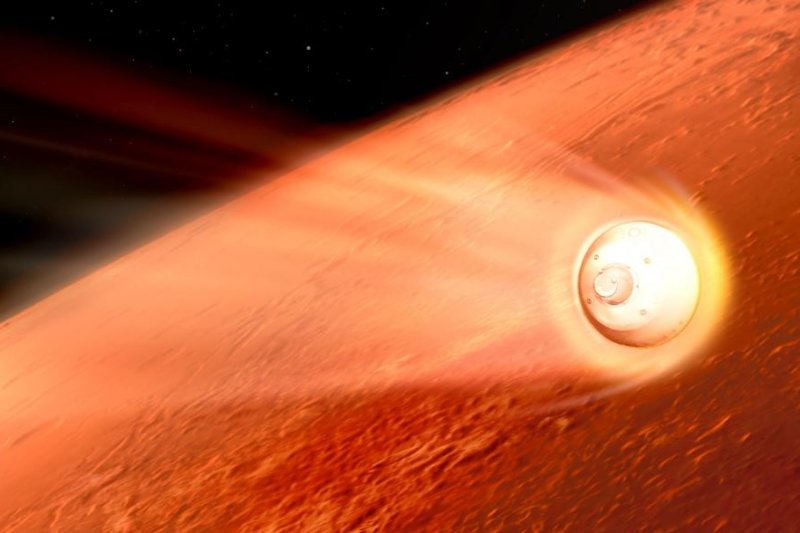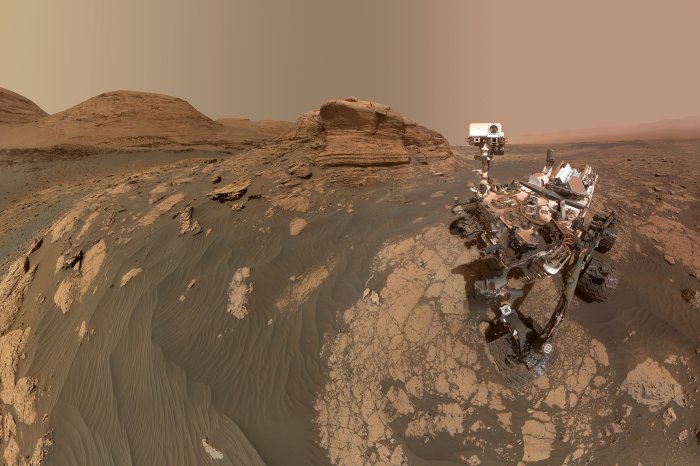1 of 3 | NASA's Mars rover Perseverance, shown in an artist's rendering streaking through the Red Planet atmosphere, is scheduled to land Thursday. Image courtesy of NASA
ORLANDO, Fla., Feb. 18 (UPI) -- NASA's planned landing of the Mars rover Perseverance at 3:55 p.m. EST Thursday will begin a process to advance exploration and understanding of the Red Planet by leaps and bounds -- if all goes well.
New landing technology being employed is vital to future missions, especially if humans are ever to set foot on Mars, Steve Jurczyk, NASA's acting administrator, said in an interview Wednesday.
Perseverance "has hazard avoidance and precision landing capability that is going to be really important when we need to land multiple systems on the surface to prepare for human missions to Mars," Jurczyk said.
The primary purpose of NASA's new, $2.4 billion rover mission is to drill rock samples in an area that the space agency identified as an ancient lakebed -- where conditions to support life probably existed. But that science mission doesn't conflict with NASA's human exploration goals, Jurczyk said.
NASA wants to know if life existed, or still exists, on Mars before humans travel there, he said. But the Perseverance mission also has experiments to support human exploration, such as a chamber in which toxic Martian air will be converted to oxygen, and a helicopter that will demonstrate flight on another planet -- in this case one with a thin atmosphere and intense cold.
Test period
Those projects won't start immediately. Minutes after landing, all NASA will receive are a few tones or sounds indicating that parachutes deployed and that the rover is intact. In the hours after landing, and for the next two months, NASA will test the rover's systems and capabilities.
Depending on how long those tests take, the rover could drop the 4-pound, solar-powered helicopter within weeks for its first of perhaps 10 test flights.
The helicopter, Ingenuity, will take photos of the rover and of the surrounding landscape. NASA will use photos from the helicopter and Perseverance to scope out a landing site for a planned future mission that will collect the rover's rock samples and launch them into a Mars orbit for eventual return to Earth.
All of that is completely in line with NASA's proposed "moon to Mars" Artemis plan, Jurczyk said, which includes a 2024 goal for landing astronauts on the moon again. After that, NASA intends to establish a base on the moon that could serve as a stepping stone to Mars.
Legislators haven't funded much of what NASA wants for such ambitions, however. In 2019, Congress cut NASA's funding request for $1 billion to build a human landing system to $600,000 for the fiscal year.
This fiscal year, the agency sought $3.2 billion for the landing system, but Congress appropriated only $850 million.
But the planning goes on.
"I really see this continuous integrated plan for Artemis across human exploration, robotic exploration and technology missions," Jurczyk said.
A lot has to go right Thursday to advance those plans, NASA officials noted in a press briefing Wednesday from NASA's Jet Propulsion Laboratory in Pasadena, Calif. After entering the atmosphere and slowing down under a parachute, the rover's sensors will scan the terrain for a safe landing site and compare those images to maps stored in its database.
Another NASA rover, Curiosity, performed most of those steps when it landed in August 2012, but Perseverance has a riskier landing spot strewn with boulders and drop-offs. That's where the new hazard avoidance technology will be vital, said Matt Wallace, the mission's deputy project manager.
Curiosity still operating
Curiosity had a roughly two-year lifespan, but still is operating and sending back data on rock samples at its location in Gale Crater after more than eight years.
The entire descent will be "something like a controlled disassembly of the spacecraft" due to the number of pieces and elements coming off the vessel, Wallace said.
After Thursday, the NASA mission will focus on trying "to understand the habitable environment and whether there were habitable environments on Mars," said Lori Glaze, director of NASA's Planetary Science Division.
Perseverance, which has a small nuclear power generator, is designed to traverse Mars for two years. Like Curiosity, it is likely to last longer but NASA is reluctant to talk about anything beyond the planned -- and budgeted -- life expectancy.
Moves more quickly
Perseverance will move three times faster than Curiosity, which averages about 600 feet per day, depending on tasks it performs.
Construction of the rover, which began in 2018, continued through the first months of the COVID-19 pandemic in spring 2020.
Glaze and other engineers and scientists will gather in Pasadena to watch and listen for the first signals to come back after the landing.
"We've taken a methodical approach to better understand how to look for life and all of our rovers have played important roles in, in trying to prove that understanding," Glaze said.
Even if Perseverance fails to discover signs of life, NASA believes the mission will prove that life doesn't necessarily spring up wherever conditions for life are possible -- also a significant advance for science.
NASA’s Curiosity Mars rover used two different cameras to create this panoramic selfie, comprised of 60 images, in front of Mont Mercou, a rock outcrop that stands 20 feet tall on March 26, 2021, the 3,070th Martian day, or sol, of the mission. These were combined with 11 images taken by the Mastcam on the mast, or "head," of the rover on March 16. The hole visible to the left of the rover is where its robotic drill sampled a rock nicknamed "Nontron." The Curiosity team is nicknaming features in this part of Mars using names from the region around the village of Nontron in southwestern France. Photo courtesy of NASA/JPL-Caltech/MSSS
















